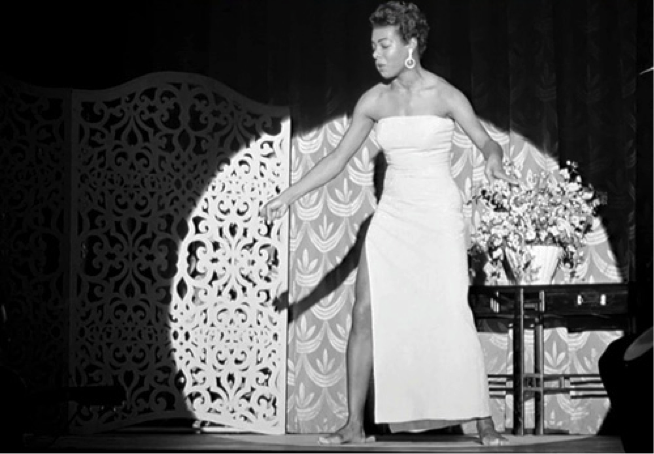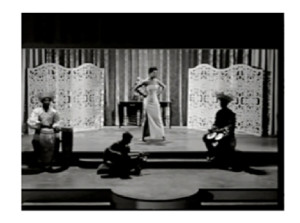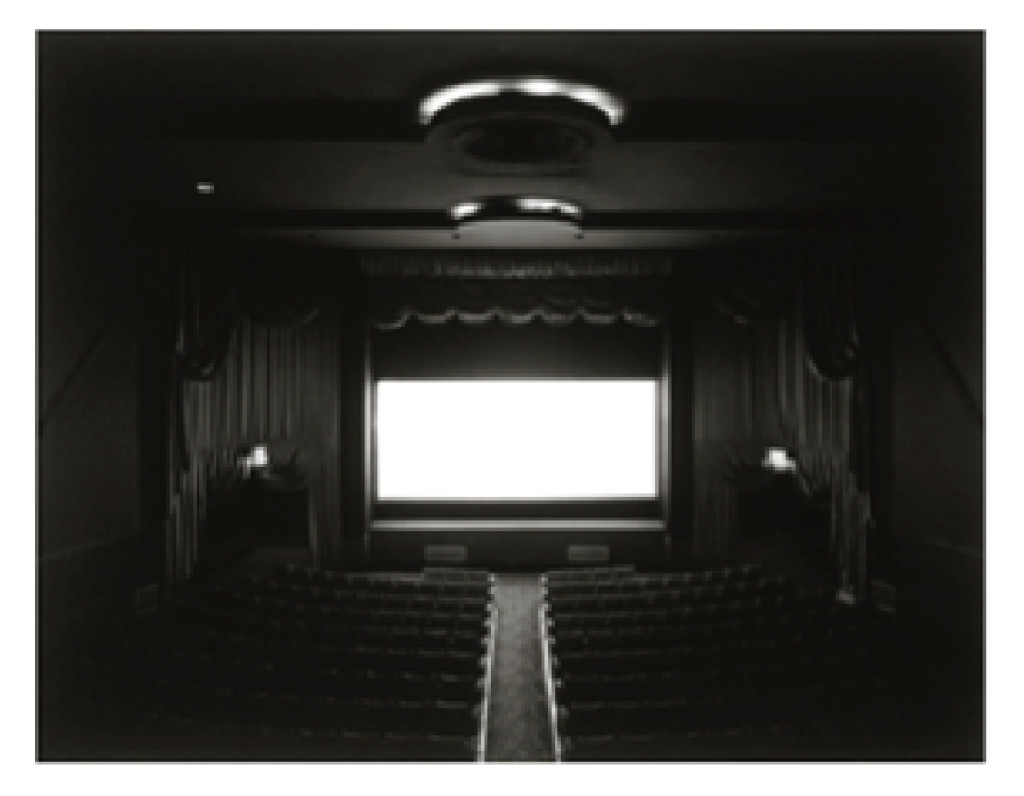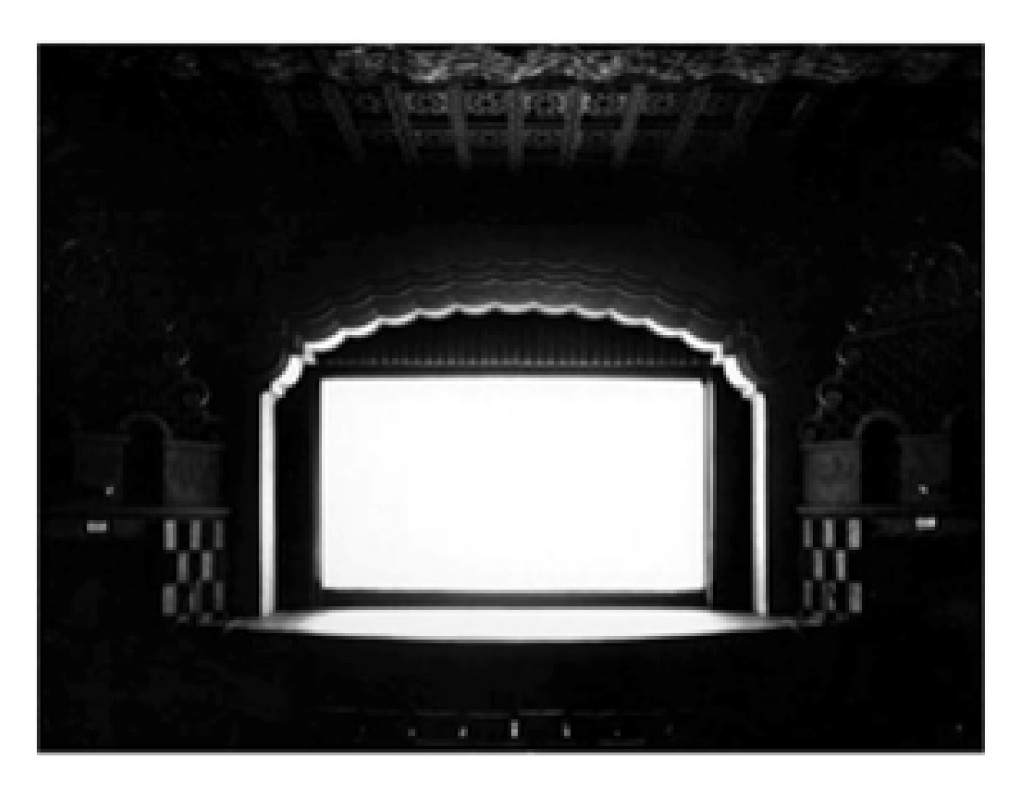Projection without representation: Screening Maya Angelou in Calypso Heat Wave
Shane Vogel

Click to view film clip in criticalcommons.org: “Maya Angelou’s Performance in CALYPSO HEAT WAVE (1957)”
In a fleeting moment in an even more fleeting film, a young Maya Angelou performs a number set in a New York City broadcasting studio that illuminates something about race, media, entertainment, and time during the 1950s calypso craze. Begun by Harry Belafonte’s record-breaking LP Calypso in 1956, the calypso craze was a transnational iteration of a long pattern of racial fads that cycled through US mass culture from the late nineteenth through the mid-twentieth century. It appeared across different types of postwar middlebrow entertainment, including sound recordings, nightclub acts, television broadcasts, Broadway musicals, and films. By early 1957, at least nine studio films were reportedly in production, though only a fraction of these were actually made. The films that were made are all notable for their self-reflexivity. They are all products of the calypso craze, but they are all also about the calypso craze. None of them tells stories of Trinidadian carnival or presents scenes of island folk music. Rather, they are backstage stories about record producers or nightclub impresarios trying to capitalize on the calypso craze. Films were made about the fad in the fad’s idiom, and then in turn were consumed as part of the fad. In other words, all of these films are films about themselves. This dynamic highlights the autogenerating and self-replicating dynamic of black fad performance more generally.
This epistemological stance of knowingness created incongruous moments that provide insight into the cinematic (re)production of race and nation. One such moment occurs in Angelou’s performance in the 1957 film Calypso Heat Wave. [1] The scene reproduces a number from her theatrical revue, also titled Calypso Heat Wave that ran in New York City in the first half of 1957. In this scene she appears as herself, an index of the real, on a nightclub stage barefoot but adorned in an elegant white evening gown. Three musicians in stereotypical island garb sit in the shadows around her. Among the many striking things about this number is the use of lighting effects to illuminate Angelou. She begins singing in the shadows, but over the course of the song a bright spotlight repeatedly opens and closes on her body in time with the sped up or slowed down tempo of the song. Throughout, she does not move from her position in the center of the stage. She is fixed and remains still, using only deliberate and controlled gestures from her upper body to comment on the song. If there is any movement at all in her performance, it is manufactured by the spotlight itself, which feels almost desperate in its effort to compel her to move while simultaneously containing that movement.
We could view this scene as the black fad performer’s capture by the technologies of mass culture. Angelou is fixed by the spotlight and rendered exposed and hypervisible to the spectator. The spotlight heightens the policing of the black woman’s body by spectatorial regimes of racialization and allegorizes the conditions of labor for the black female entertainer in the Jim Crow era. She is continuously appearing and disappearing, constantly revealed and hidden. Whenever the tempo of the song slows down enough that she might escape it, the spotlight returns, compelling her to sing her song for the audience. The song she performs only underscores this dynamic: “Run Joe” was a song that Angelou recorded about two men arrested by the police for running a backroom fortune telling business. As one escapes, the other issues him instructions to destroy evidence and create an alibi for himself. As part of the staging of the song, the spotlight becomes a kind of police searchlight seeking out acts of criminality in its beam, resembling nothing so much as the helicopter beams that punctuate the Los Angeles of Boyz n the Hood four decades later.
Alongside such an understanding of how this scene represents blackness, however, I want to propose a different, formalist, analysis in order to ask what this scene might tell us about the relationship between race, cinematic representation, and sound. I here bracket psychoanalytic film theory that is concerned with identification, fantasy, and the gaze and think instead about the cinematic apparatuses that makes such images possible: the screen and the projector. In doing so, I will attempt to think of race in the calypso craze not as something (mis)represented by mass media but as the very medium of representation itself: race as both the apparatus and the interval, the technology that makes representation possible and the temporal span in which certain images become animate. Understood as medium rather than representation, race is that which structures sight and sound, making certain things visible and audible and others invisible and inaudible. To think of race as such an “intervening substance” for the senses is the proposal made by scholar W. J. T. Mitchell in his 2010 W. E. B. Du Bois Lectures delivered at Harvard University. For Mitchell, race is “not something to be seen, but is itself a framework for seeing through or (as Wittgenstein would put it) seeing as.” [2]
This notion of race as a framework for seeing—as a medium—is anticipated in Frantz Fanon’s well-known description of his experience going to the movies. Fanon describes film as a racializing technology and the feeling of dread that fills him as he waits for the movie to begin: “I cannot go to a film without seeing myself. I wait for me. In the interval, just before the film starts, I wait for me. The people in the theater are watching me, examining me, waiting for me. A Negro groom is going to appear. My heart makes my head swim.” [3] Kaja Silverman, like most film theorists who take up this Fanonian scene, points out that it is the audience that structures Fanon’s double consciousness. “Since the film has not yet begun,” Silverman writes, “the representations within which Fanon feels obliged to recognize himself seem to derive directly from the personal prejudices of the audience. The power to confer meaning seems to be immanent within the collective white look.” [4] While Silverman is surely right in her attention to the audience that surrounds Fanon (though as Kara Keeling reminds us, Fanon himself never specifies the color of the audience), there is another element of this mise-en-scène that shapes Fanon’s dread: the screen. [5] The people in the audience, including Fanon, are waiting for Fanon to appear on the screen. The time of this scene is significant: the interval just before the film starts, when most eyes are focused expectantly on the unilluminated screen. Fanon’s look at the blank screen is saturated with anticipation for the image of blackness that is going to appear. But in the interval, it is the screen itself that Fanon contemplates in angst, as the image has not yet arrived. Here Fanon draws our attention not only to the inevitable representation of the black imago but also to the technological apparatuses that makes it possible: the screen and the projector. The screen is that which allows for any image of blackness or whiteness—of race—to appear at all. It is the expectation of projection, the arrival of the groom on the screen, that Fanon dreads and anticipates.
Angelou’s sequence in Calypso Heat Wave reintroduces this interval or moment of anticipation back into the event that has already begun. That is, she becomes the screen onto which the projector projects. The staging makes us aware of the role of race as medium, as screen or veil, as much as it is thing represented. Angelou’s image has a double function. First it represents the performer and her performance on film, indexing Angelou’s nightclub act and bringing it to a national audience. At the same time, Angelou’s image ceases to be a representation and instead becomes the very thing that makes the cinematic image possible: Angelou herself becomes both the screen and the act—rather than the object—of projection.
As the aperture of the spotlight repeatedly opens and closes on the performer, the scene doubles the projection of the film in the movie theater in which viewers would have seen it in 1957.
The mise-en-scène further draws our attention to this multiplication of screens, surfaces, and curtains. Angelou is positioned as a screen among a variety of other screens. She appears on stage before a heavy theater curtain and is flanked on either side by two ornate carved ivory screens. The spotlight further doubles her (or doubles her again) by casting a shadow figure on the curtain behind her that follows her movements.
This other screen—this third screen; the screen behind the screen; the shadows that dance on the back side of the screen—reminds us that what lies off-screen is not a real blackness that might be properly represented or otherwise distorted by mass media but is the negation of that representation, an outline or shadow that can never be properly filled in by the technologies of mass media. The screen is both something projected-upon and something that conceals. Ghosting her exact movements, this animated silhouette counters the indexical desire of cinematic reproduction that would offer the spectator the real off-screen “Maya Angelou.” This scene does not simply represent Angelou but also becomes a commentary on the conditions of possibility for cinematic racial representation itself. Angelou prolongs the Fanonian interval, turning the sequence not into the arrival of a racial distortion but deferring any such arrival by offering herself not as image but as a screen that is both empty and overfull at the same time.
A helpful example of what I mean by this last claim can be found in a brief digression on the work of Japanese photographer Hiroshi Sugimoto, specifically his series Theaters begun in the late 1970s.
According to the artist, this project was driven by a particular thought experiment: “Suppose you shot a whole movie in a single frame? And the answer: you get a shining screen” (emphasis in original). [6] To discover this answer, Sugimoto took a large 4×5 camera into various movie houses and set up his tripod at the back of the theater. When the film began, he opened the camera’s shutter and left it open for the entire length of the film. When developed, the single overexposed image reveals a screen that glows with an uncanny illumination. Despite its appearance, the screen is not in fact empty; rather it is too full. It contains all the images of the film at the same moment. In its oversaturation, Sugimoto’s photograph reveals the cinematic not as a series of represented images or as a narrative story unfolding sequentially but as a collection of images happening all at once, an interval of blinding vision that explodes narrative and representation. In the artist’s words, “That evening I developed the film and the vision exploded behind my eyes.” [7] Sugimoto’s series envisions projection without representation. It is this notion of pure projection that the cinematic temporality of linear narrative obscures.
Projection without representation is also what Angelou’s performance in Calypso Heat Wave evokes (and I do not mean psychological projection, which would leave us locked in the prison house of representation). Even as her stage performance is projected onto the screen of a 1957 movie theater, within the film the spotlight doubles this projection by projecting onto Angelou herself, turning her into the screen. This cinematic self-reflexivity interrupts the easy notion that black and white are known categories that, as Keeling explains, allow us to measure positive or authentic images against negative or inauthentic images. [8] Rather, by highlighting the materiality of the screen as medium and Angelou herself as the screen, this sequence figures race not as mere representation but as the very medium that makes representation possible. Race occurs here not as something that precedes media or even as something socially constructed by media but rather as a spatial and temporal medium. Read not in terms of content but in terms of a commentary on medium, race appears in this scene as a kind of screen that is both projected upon and conceals. As Mitchell puts it, the racial medium “can both obstruct and facilitate communication; [be] a cause of misunderstanding and blindness, or conversely, a mechanism of ‘second sight’; [be] a prosthesis that produces invisibility and hypervisibility simultaneously, as Ralph Ellison’s tale of the invisible man tells us.” [9] Or as Roland Barthes reminds us, paraphrasing André Bazin, “the screen is not a frame but a hideout.” [10]
Paradoxically, Angelou’s commentary on the screen becomes most fully realized as an act of listening. Just as screens within screens visually shape this scene, so too do audiences within audiences sonically shape it. Angelou’s performance kicks off a live radio broadcast of “the first all calypso carnival in America” broadcast across the airwaves. Her performance is followed by several other acts introduced by an emcee. Though it seems that this performance occurs at a happening nightclub late into the evening, this setting is part of a radio studio and occurs in the middle of the day. The live audience watching and listening to her performance are part of the broadcast; like Angelou, they too are amplified and disseminated across the airwaves as part of the performance by the technological apparatuses in the soundproof radio broadcasting room. On the one hand, Angelou’s performance expands beyond this local audience that witnesses her to a national one that only listens to her. On the other hand, the relationship between looking and listening is a shifting and supplemental one, an augmentation of the senses in which the visual performance allows for its fullest realization in the sound of the song. In an important formulation, Fred Moten describes this relationship between the visual and the aural, which is also a commentary on the scene of listening itself and helps us to understand listening as a mode of onscreen behavior. Moten writes:
If the sensual dominant of a performance is visual (if you’re there, live, at the club), then the aural emerges as that which is given its fullest possibility by the visual: you hear Blackwell most clearly in seeing him—the small kit, the softness and slow grace of his movement; or Cecil most clearly in the blur of his hands. Similarly, if the sensual dominant in the performance is aural (if you’re at home, in your room, with the recording), then the visual emerges as that which is given its fullest possibility by the aural: you see Blackwell most clearly in hearing the space and silence, the density and sound, that indicate and are generated by his movement; or Cecil most clearly in sound’s anticipation of dance at, to, and away from the instrument. These are questions of memory, descent, and projection. The visual and the aural are before one another. [11]
That we are brought into the broadcast booth for much of the movie’s final sequence reminds us that for the film’s imagined listening audience, gathered around radios across the country, Angelou’s performance is not seen but heard. In this sense, we can hear the tempo of the song (as it speeds up and slows down) alongside the play of the spotlight (as it opens and closes on Angelou) as sonically and visually responding to each other. One becomes fully heard and seen only through the sight and sound of the other. For the film’s viewers, the sensual dominant allows us to hear Angelou most clearly in the visual (anti-)spectacle I have described. For the fictional listeners to her broadcast, the sensual dominant is most fully realized in the blank screen she presents. This is another way of saying that the songs of the calypso craze offer not access to an authentic folk culture or world music but constitute an aural screen homologous to Angelou’s visual screen in this Calypso Heat Wave number. The visual and the aural are before one another, Moten writes, and as depicted in the scene continually prolong the Fanonian interval that Angelou reintroduces into the film by posing and sounding as the apparatuses of cinematic reproduction: broadcast booth and screen. In this sense, Angelou’s performance provides a key way to understand the fad itself as a sonic projection without representation: song as surface.
Of course, we do not know how these final directing decisions were made, though it is not beyond possibility that Angelou herself determined them. “Run Joe” was a number she performed in her calypso nightclub revue, and in many of these films directors often simply reproduced each musical act as it appeared on stage. And the manipulation of tempo and time signature was Angelou’s own contribution to the arrangement; the original song proceeds at an upbeat pace. But my argument is less historical than aesthetic: how should we read the aural form of this scene? What do we hear when we listen not for the content of the lyrics but for the very form of sonic presentation? My claim that this scene enacts the calypso craze’s relationship to itself and its relationship to blackness does not rely on any conscious choice by actor or director; it is immanent to the logic of the racial fad. The calypso craze, like other race crazes, was autogenerating and tautological. It referred to nothing other than itself. Its sonic referent was not a Trinidadian folk culture but the manufacture and dispersal of calypso consumption across sound media: film, records, television specials, nightclub acts. There was never even a failed promise of an authentic blackness that was corrupted by the craze; blackness was already rendered inauthentic in the fad’s films and recordings. The racial fad was a sonic feedback loop and a screen that projected itself onto itself, continuously revealing that it was nothing other than screen. Within such a spotlight—which is sonically as well as visually illuminating—Angelou draws attention to the function of race as medium and helps us to imagine the cinema not only as a location for the visual and sonic project(ion) of racial representation, to be celebrated or contested, but also to imagine race as the very condition for such a project(ion) and the potential explosion of vision and sound.
Shane Vogel is associate professor of English and director of the Cultural Studies Program at Indiana University. He is the author of The Scene of Harlem Cabaret: Race, Sexuality, Performance (University of Chicago Press, 2009).
Notes
[1] Calypso Heat Wave, directed by Fred Sears. Performed by Maya Angelou. (1957; Columbia Pictures).
[2] W. J. T. Mitchell, Seeing through Race (Cambridge, Mass.: Harvard University Press, 2012), 13.
[3] Frantz Fanon, Black Skin, White Masks, trans. Charles Lamm Markmann (New York: Grove, 1967), 140. The Richard Philcox translation renders this passage as: “I can’t go to the movies without encountering myself. I wait for myself. Just before the film starts, I wait for myself. Those in front of me look at me, spy on me, wait for me. A black bellhop is going to appear. My aching heart makes my head spin.” Black Skin, White Masks, trans. Richard Philcox (New York: Grove, 2008), 119.
[4] Kaja Silverman, The Threshold of the Visible World (New York: Routledge, 1996), 27.
[5] Kara Keeling, The Witch’s Flight: The Cinematic, the Black Femme, and the Image of Common Sense (Durham: Duke University Press, 2007), 38.
[6] Hiroshi Sugimoto, “Theaters,” Accessed on 26 October 2014, http://www.sugimotohiroshi.com/theater.html.
[7] Ibid.
[8] Keeling, The Witch’s Flight, 27.
[9] Mitchell, Seeing through Race, 13.
[10] Roland Barthes, Camera Lucida: Reflections on Photography, trans. Richard Howard (New York: Hill and Wang, 1981), 55.
[11] Fred Moten, In The Break: The Aesthetics of the Black Radical Tradition (Minneapolis, University of Minnesota Press, 2003), 172-173.






